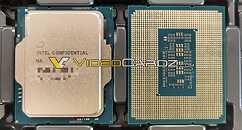Wednesday, February 24th 2021

Intel Alder Lake Processor Tested, Big Cores Ramp Up to 3 GHz
Intel "Alder Lake" is the first processor generation coming from the company to feature the hybrid big.LITTLE type core arrangement and we are wondering how the configurations look like and just how powerful the next-generation processors are going to be. Today, a Geekbench submission has appeared that gave us a little more information about one out of twelve Alder Lake-S configurations. This time, we are getting an 8-core, 16-threaded design with all big cores and no smaller cores present. Such design with no little cores in place is exclusive to the Alder Lake-S desktop platform, and will not come to the Alder Lake-P processors designed for mobile platforms.
Based on the socket LGA1700, the processor was spotted running all of its eight cores at 2.99 GHz frequency. Please note that this is only an engineering sample and the clock speeds of the final product should be higher. It was paired with the latest DDR5 memory and NVIDIA GeForce RTX 2080 GPU. The OpenCL score this CPU ran has shown that it has provided the GPU with more than enough performance. Typically, the RTX 2080 GPU scores about 106101 points in Geekbench OpenCL tests. Paired with the Alder Lake-S CPU, the GPU has managed to score as much as 108068 points, showing the power of the new generation of cores. While there is still a lot of mystery surrounding the Alder Lake-S series, we have come to know that the big cores used are supposed to be very powerful.
Source:
Geekbench
Based on the socket LGA1700, the processor was spotted running all of its eight cores at 2.99 GHz frequency. Please note that this is only an engineering sample and the clock speeds of the final product should be higher. It was paired with the latest DDR5 memory and NVIDIA GeForce RTX 2080 GPU. The OpenCL score this CPU ran has shown that it has provided the GPU with more than enough performance. Typically, the RTX 2080 GPU scores about 106101 points in Geekbench OpenCL tests. Paired with the Alder Lake-S CPU, the GPU has managed to score as much as 108068 points, showing the power of the new generation of cores. While there is still a lot of mystery surrounding the Alder Lake-S series, we have come to know that the big cores used are supposed to be very powerful.


41 Comments on Intel Alder Lake Processor Tested, Big Cores Ramp Up to 3 GHz
3ghz cores competitive with 4 to 5ghz cores in early benches, what do you think that means? Or is math too difficult?
wait what? I thought the whole deal with these was the big-little design....now we are getting just traditional cpu's with not little cores?
and I know we talked about this already but man...what is Intel's plan here regarding Rocket Lake...its nice they are transparant about Alderlake being around the corner but....why even release Rocket Lake at this point?not entirely sure how you are going to apply math to this but sure.
Nobody was told the CPU doesnt have the little gracemont cores, and that geekbench even support seeing such thing at this point.
Nobody was told what the final frequency would be for the product, or how boost behavior is going to act like.
this early leaks are a waste of time, whoever leaked this, plz do a proper cpu geekbench benchmark next time, so we can see what those ES 3.0 ghz can do compared to what we have now
and why rocket lake even exists at this point if something like this is around the corner rocking more IPC & DDR5, rocket lake is looking like the first Gen Core series that got demolished by Sandy Bridge right after
has a fair bit of catching up to do then as my R7 3700X @ 4.25GHz and RX6800 gets 125858 points
BTW, is there any info or signs pointing to more than one variant of Alder Lake silicon?
I highly doubt it will go that much higher than 3 GHZ, MAYBE 4!
If the marketing was shifted away from 'moar higher' numbers and instead the focus was on real performance metrics (resulting performance, as in, 'compiles in X seconds' or 'framerate') we would not have this problem and boost would not have to be extended to ridiculous just to meet marketing desires. At the same time, boost technology does need to evolve and find the very limit of what it can do to be a 'proper boost'.
It would also bypass the recent discussions we've had on bursty boosting and some CPUs not even meeting the boost they were rated for (Ryzen) albeit briefly. You could wonder how relevant it really is, because you're not using a CPU to watch it gain a certain frequency, you want it to do work.
Perhaps a good comparison is the WLTP rating for E-vehicles. Its a single metric allowing us to compare range between cars based on the same parameters. If you pull up hard and fast a lot and put your heater on all the time, you won't be hitting it - but that's what CPUs have started doing regardless. Power budget is messed with, we get extended limits, etc. What you would want is for the CPU to be more controllable that way. Give us eco and sport toggles - and review CPUs based on those 'stock settings' offered with the product. That's playing fair. @W1zzard already does something along those lines with the testing on max power and turbo in reviews. More control over boost would be the long term desire - a slider that relates CPU performance to the cooling capacity that's placed on it, perhaps even automated / based on a system test. Right now that is sort-of automated but only based on internal metrics, there is no user control, because then you're essentially overclocking.
Note how Intel already developed a tool for at least measuring the maximum output and Nvidia also has automated its overclock (boost) voltage setup.
If true though... man, Intel really is frankensteining the hell out of all their designs lately. Every little helps...eh big helps.
Me, I'm happy if I'm right 3 out of 4 times. Depending on the subject at hand, I can be wrong way more than that.
Now why didn't anyone else think of making CPUs with just big cores .......
Not that marketing has a problem selling any kind of crap, but I think they would have had a harder time explaining why you need the low-power cores on a desktop.
And again, it's not confirmed desktop parts will lack little cores. It's just what we believe based on a report from one benchmark. using an engineering sample.
That way for the 99% of the tasks the small cores would be as fast as the large ones at much lower power consumption, potentially allowing for higher clocks.
My my...